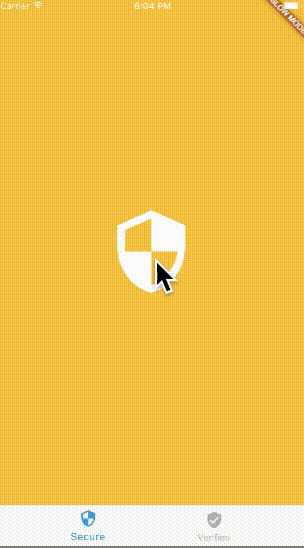如何在Flutter中获取当前路线路径?
在实现持久性底部栏时,单击底部栏中的按钮时,需要恢复以前的路线。
单击底部栏中的按钮时,将保存其当前路径路径(/ a / b /
c
),并根据该按钮单击恢复先前保存的路径。
从概念上讲,用户会将每个按钮视为一个工作区,并且其状态永远不会丢失(包括后退堆栈)。用户可以安全地从一个工作区切换到另一个工作区。
当路由重绕到根时,如何在Flutter中获取当前路由路径?
问题答案:
NavigatorState不会公开用于获取当前路线路径的API,Route也不会公开用于确定路线路径的API。路由可以是(通常是匿名的)。Route使用该isCurrent方法,您现在可以确定给定对象是否位于导航器堆栈的顶部,但这对于您的用例而言并不十分方便。
我建议您对这个问题采取不同的方法,并且根本不要倒回根本。相反,请Navigator对的每个窗格使用不同的小部件BottomNavigationBar。这样,您在窗格之间切换时就不必倒回堆栈。你可以用你的Navigator小部件Opacity和IgnorePointer部件来隐藏他们时,他们不应该是不破坏他们的筹码可见。

import 'package:flutter/material.dart';
void main() {
runApp(new MyApp());
}
class MyApp extends StatelessWidget {
@override
Widget build(BuildContext context) {
return new MaterialApp(
home: new MyHomePage(),
);
}
}
class SecurePage extends StatelessWidget {
final int index;
SecurePage(this.index);
Widget build(BuildContext context) {
return new Material(
color: Colors.amber,
child: new InkWell(
child: new Center(
child: new Icon(
Icons.security,
color: Colors.white,
size: index * 100.0 + 20.0,
),
),
onTap: () {
Navigator.of(context).push(
new MaterialPageRoute(
builder: (BuildContext context) {
return new SecurePage(index + 1);
},
),
);
},
),
);
}
}
class VerifiedPage extends StatelessWidget {
final int index;
VerifiedPage(this.index);
Widget build(BuildContext context) {
return new Material(
color: Colors.green,
child: new InkWell(
child: new Center(
child: new Icon(
Icons.verified_user,
color: Colors.white,
size: index * 100.0 + 20.0,
),
),
onTap: () {
Navigator.of(context).push(
new MaterialPageRoute(
builder: (BuildContext context) {
return new VerifiedPage(index + 1);
},
),
);
},
),
);
}
}
class MyHomePage extends StatefulWidget {
@override
State createState() => new MyHomePageState();
}
class MyHomePageState extends State<MyHomePage> {
int _page = 0;
List<Widget> initialWidgets = <Widget>[
new SecurePage(0),
new VerifiedPage(0),
];
Widget build(BuildContext context) {
return new Scaffold(
body: new Stack(
children: new List<Widget>.generate(initialWidgets.length, (int index) {
return new IgnorePointer(
ignoring: index != _page,
child: new Opacity(
opacity: _page == index ? 1.0 : 0.0,
child: new Navigator(
onGenerateRoute: (RouteSettings settings) {
return new MaterialPageRoute(
builder: (_) => initialWidgets[index],
);
},
),
),
);
}),
),
bottomNavigationBar: new BottomNavigationBar(
currentIndex: _page,
onTap: (int index) {
setState(() {
_page = index;
});
},
items: <BottomNavigationBarItem>[
new BottomNavigationBarItem(
icon: new Icon(Icons.security),
title: new Text('Secure'),
),
new BottomNavigationBarItem(
icon: new Icon(Icons.verified_user),
title: new Text('Verified'),
),
],
),
);
}
}
-
在实现持久底部栏时,当单击底部栏中的按钮时,需要恢复以前的路由。 单击底部栏中的按钮时,会保存其当前路线路径(/a/b/c ),并根据按钮的单击恢复先前保存的路线。 从概念上讲,用户会认为每个按钮都是一个工作区,其状态永远不会丢失(包括后退堆栈)。用户可以安全地从一个工作区切换到另一个工作区。 当路由重绕到根时,如何在Flutter中获取当前路由路径?
-
当前文档只讨论获取路由参数,而不是实际的路由段。 例如,如果我想找到当前路由的父级,怎么可能?
-
问题内容: 如何在Symfony 2中获得当前路线? 例如: 我如何获得该价值? 问题答案: 从ContainerAware(例如控制器)中:
-
问题内容: 在Flask中,当我为同一功能使用多个路由时,如何知道当前使用的是哪个路由? 例如: 我怎么知道,现在我被称为使用或? 更新 我知道我不想使用它,因为请求可能相当复杂,并且我想在函数中重复路由逻辑。我认为最好的解决方案。 问题答案: 检查触发你的视图的路线的最“轻松”方法是request.url_rule。
-
我需要得到当前路径的url在路由更改和基于值我想做条件渲染 这是我的代码,我没有继续的想法。 所以我需要做的是: 对于每个更改,我需要更新的值,并进行条件渲染,并将该值(路径)作为
-
我有一个路由器像下面: 以下是我想要实现的目标: 如果未登录,将用户重定向到 如果用户在登录后试图访问,请将其重定向到root 因此,现在我尝试在

